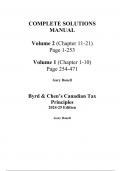COMPLETE SOLUTIONS
MANUAL
Volume 2 (Chapter 11-21)
Page 1-253
Volume 1 (Chapter 1-10)
Page 254-471
Gary Donell
Byrd & Chen’s Canadian Tax
Principles
2024-25 Edition
Gary Donell
, Instructor’s Solutions Manual, Byrd & Chen’s Canadian Tax Principles 2024/25 Edition
Instructor’s Solutions Manual
Chapter 11 – Solutions to Assignment Problems
Solution to AP 11-1
2021 Analysis
The required information can be calculated as follows:
ITA 3(a)
Business Income $18,000
Taxable (Grossed Up) Dividends 2,360 $20,360
ITA 3(b)
Taxable Capital Gains $ 600
Allowable Capital Losses (2,100) Nil
ITA 3(c) $20,360
ITA 3(d)
Unrestricted Farm Loss (See Note) (6,250)
2021 Net Income and Taxable Income $14,110
Note Ms. Breau’s farm losses are restricted as follows:
Total Farm Loss $10,000
Unrestricted Amount:
First $2,500 ($ 2,500)
One-Half of $7,500 ($10,000 – $2,500) (3,750) (6,250)
2021 Restricted Farm Loss $ 3,750
As noted in the problem, none of the losses can be carried back before 2021. This would
leave the following 2021 loss carryover balances:
• 2021 Restricted Farm Loss $3,750
• 2021 Net Capital Loss [($2,100 (ITA 3(b)(ii)) – $600 (ITA 3)(b)(i))] $1,500
In this first year the taxable income is less than the required $15,705 to fully utilize available
personal tax credits; however, there is no choice to limit any of the ITA 3 amounts to a smaller
amount so as to achieve the $15,705 taxable income.
2022 Analysis
The required information can be calculated as follows:
ITA 3(a)
Farm Income $ 2,000
Taxable (Grossed Up) Dividends 2,950 $4,950
ITA 3(b)
Taxable Capital Gains $ 1,000
Allowable Capital Losses Nil 1,000
Copyright © 2025 Pearson Education Inc. 11-1
, Instructor’s Solutions Manual, Byrd & Chen’s Canadian Tax Principles 2024/25 Edition
ITA 3(c) $5,950
ITA 3(d)
Non-Farming Business Loss (14,000)
2022 Net Income Nil
2021 Net Capital Loss ($1,000)
2022 Taxable Income Nil
Since there are $1,000 of net taxable capital gains this year, and the problem states that Ms.
Breau would like to deduct the maximum amount of net capital losses, the net capital loss of
$1,000 is applied against the ITA 3(b) amount of $1,000, which effectively increases the
2022 non-capital loss.
The 2022 non-capital loss is calculated as follows:
Business Loss $14,000
Add: 2021 Net Capital Loss Deducted 1,000
ITA 3(c) Income (5,950)
2022 Non-Capital Loss $ 9,050
The entire 2022 non-capital loss could be carried back to 2021, but since Ms. Breau requires
$15,705 in taxable income to fully utilize her personal tax credits, no carry back is
contemplated.
There would be the following loss balances at the end of 2022:
• 2021 Restricted Farm Loss (Unchanged) $3,750
• 2021 Net Capital Loss ($1,500 – $1,000)] $ 500
• 2022 Non-Capital Loss $9,050
2023 Analysis
The required information can be calculated as follows:
ITA 3(a)
Non-Farming Business Income $30,000
Farm Income 3,150
Taxable (Grossed Up) Dividends 3,963 $37,113
ITA 3(b)
Taxable Capital Gains $ 2,000
Allowable Capital Losses Nil 2,000
2023 Net Income $39,113
2021 Restricted Farm Loss (Equal to Farm Income) (3,150)
2021 Net Capital Loss (Less than the $2,000 taxable capital gain) (500)
2022 Non-Capital Loss Carry Forward (All) ( 9,050)
2023 Taxable Income $26,413
There would be the following loss balances at the end of 2023:
• 2021 Restricted Farm Loss ($3,750 – $3,150) $ 600
2024 Analysis
The required information can be calculated as follows:
Copyright © 2025 Pearson Education Inc. 11-2
, Instructor’s Solutions Manual, Byrd & Chen’s Canadian Tax Principles 2024/25 Edition
ITA 3(a)
Taxable (Grossed Up) Dividends $ 6,450
ITA 3(b)
Taxable Capital Gains $ 2,250
Allowable Capital Losses (7,250) Nil
ITA 3(c) $ 6,450
ITA 3(d)
Non-Farming Business Loss ($19,000)
Farm Loss (2,000) (21,000)
2024 Net Income and Taxable Income Nil
The 2024 non-capital loss can be calculated as follows:
Business Loss $19,000
ITA 3(c) Income (6,450)
Non-Capital Loss $12,550
Farm Loss (Unrestricted) 2,000
2024 Non-capital loss $14,550
The total loss carryover of $14,550 is available for carry back to any of the three preceding
years.
The 2024 net capital loss would be equal to $5,000 [ITA 3)(b)(ii) $7,250 – ITA 3(b)(i) of
$2,250)]. $1,500 of the 2024 net capital loss can be applied to the 2023 year as there is
$1,500 ($2,000 – $500) in net taxable capital gains remaining in 2023 as the basis for a carry
back. This leaves a balance of $3,500 ($5,000 – $1,500).
If both the $14,550 non-capital loss and the $1,500 net capital loss were carried back to
2023, the result would be a Taxable Income of $10,363, less than the $15,705 that is
required to fully utilize Ms. Breau’s available personal tax credits. As the 2023 net capital
loss can only be deducted to the extent of net taxable capital gains, it would be advisable to
first claim the full amount of this loss. Based on this view, the deduction of the 2024 non-
capital loss will be limited to $9,208 ($26,413 – $15,705 – $1,500), an amount that will provide
for the full use of Ms. Breau’s 2023 personal tax credits:
2023 Taxable Income (As Reported) $26,413
2024 Net Capital Loss ( 1,500)
2024 Non-Capital Loss ( 9,208)
2023 Revised Taxable Income $15,705
These loss applications leave Ms. Breau with her required $15,705 in 2023 taxable income. The
following loss balances remain at the end of 2024:
• 2021 Restricted Farm Loss $ 600
• 2024 Net Capital Loss ($5,000 – $1,500)] $3,500
• 2024 Non-Capital Loss ($14,550 – $9,208) $5,342
Solution to AP 11-2
Before the consideration of any loss carryovers, Lucinda’s taxable income for 2023 would be
as follows:
Copyright © 2025 Pearson Education Inc. 11-3




